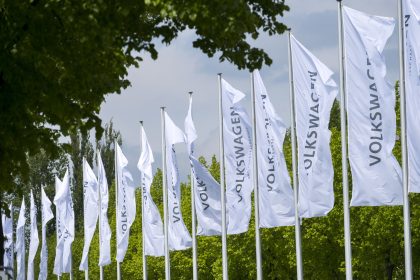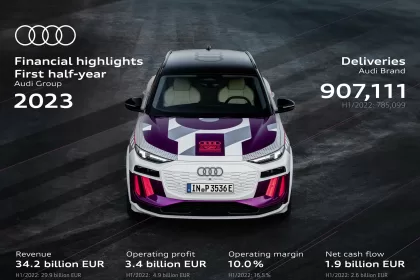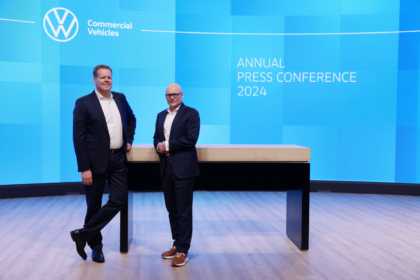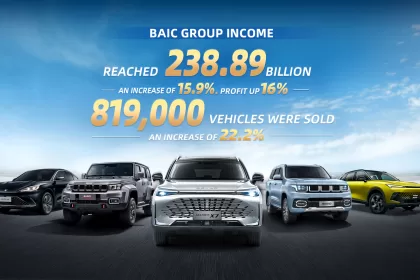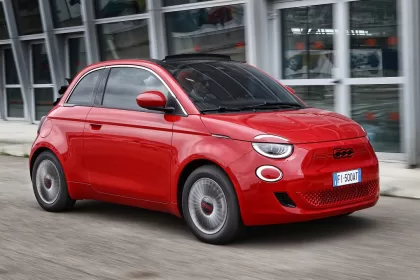Volkswagen Group posted solid H1 results for 2023, with rising sales revenue and strong underlying operating profit. This is in line with the Group’s “value over volume” strategy, announced at the recent Capital Markets Day. The Group’s BEV strategy is also making further progress, with deliveries in the first half of the year increasing by around 50 percent year-on-year. In Europe, the Group increased its BEV deliveries by as much as 68 percent, underscoring its position as market leader in Europe. As the year progresses, significantly shorter delivery times, the remaining high order bank of 1.65 million vehicles and stable demand should provide further tailwinds. The solid net liquidity of EUR 33.6 billion in the Automotive Division also gives the Group the necessary strength and flexibility to continue investing in key regions and growth areas.
Oliver Blume, CEO Volkswagen Group: “We have strategically realigned and restructured the Volkswagen Group, with a clear plan and measurable milestones. In the first half of the year, the Volkswagen Group delivered reliably with very solid results. Sales in North America are picking up, we are strengthening our position in China through technological partnerships and on top of that the trend for fully electric vehicles is moving in the right direction. What is important to us is long-term, sustainable growth, with a focus on value over volume.”
Solid results
In the first half of 2023, the Volkswagen Group achieved an operating profit before valuation effects mainly from commodity hedging outside hedge accounting of EUR 13.9 billion, an increase of about 13 percent. This resulted in a corresponding margin of 8.9 percent, above the guidance range of 7.5 percent to 8.5 percent. Operating profit came in at EUR 11.3 billion (H1 2022: EUR 13.2 billion) largely due to non-cash hedging effects mainly from commodity hedging amounting to EUR – 2.5 billion (Q1 2023 EUR – 1.3 billion; H1 2022: EUR 0.9 billion).
Overall revenue grew by 18 percent to EUR 156.3 billion in H1 (H1 2022: EUR 132.3 billion), driven by a continued recovery in volume as well as solid mix and pricing. Vehicle deliveries declined by 1 percent in China, although there were notable signs of recovery towards the end of the reporting period. Overall, the Group continued to see solid demand.
The Group’s electrification strategy continued to accelerate, with battery electric vehicles (BEV) representing a 7.4 percent share of total deliveries in the first half (compared to 5.6 percent in H1 2022) and including 18 percent year-on-year growth in China in Q2, demonstrating a positive trend. In a challenging market environment, Volkswagen was able to increase market share particularly in Europe where the Group remains the BEV segment market leader. In the context of a more challenging market environment, Volkswagen Group aims to reach a BEV share of 8-10% of total deliveries in FY 2023. Seasonal effects, along with the significantly reduced delivery times, are likely to contribute to a higher proportion of BEV sales in H2.
In view of the continuing bottlenecks in the logistics chains, net cash flow was muted at EUR 2.5 billion in the first half of the year. In anticipation of an improving logistics situation and minor production adjustments in the second half of the year, Volkswagen Group continues to target full-year net cash flow of EUR 6-8 billion and has taken decisive measures to ensure that the lower end of this range is met.
The automotive division’s net liquidity remained solid at EUR 33.6 billion at the end of H1, which will continue to support the Group’s targeted sustainable value strategy.
Arno Antlitz, CFO & COO Volkswagen Group: “In the first half of the year, we achieved solid financial results and took major steps to improve our competitiveness. The focus for the second half is now on strengthening net cash flow. With the launch of performance programs at all brands and our strategic decisions in China, we will improve the competitive position of the Volkswagen Group even further.”
Financial Outlook for FY 2023 confirmed
Volkswagen Group confirms the financial outlook for FY 2023 published on March 3, 2023. The outlook for deliveries is slightly adapted for 2023 from around 9.5 million to 9 to 9.5 million while the Group remains fully on track to meet the sales revenue goal.
As anticipated, supply chain disruptions have continued to ease in H1 2023, with pressure shifting from semiconductor shortages to transportation and logistics delays. H2 should be supported by lower raw material costs and gradually easing logistical bottlenecks. The performance programs for the brands are designed to deliver their first results in H2, further strengthening the Group’s position in an increasingly competitive environment.
In line with the steering model announced at the recent Capital Markets Day, the Group’s focus remains on meeting profitability and cash flow targets. An emphasis on value-driven production is expected to support the already strong results. Prioritizing sustainable profitability over volume growth will enable the group to meet operating margin and cash flow targets.
Acceleration of strategic transformation in China
Volkswagen Group is stepping up the pace of its transformation in China, where the Group aims to remain the most successful international OEM and amongst the top 3 in the market, building on solid existing foundations in H1.
After a challenging start in the first two months of the year, the Group’s delivery figures in China in March through May were significantly up compared to the previous year. A decrease in June was the result of a high base in the same month last year and non-recurring effects, including a tax exemption for ICE vehicle purchases and local government subsidies. Volkswagen Group China delivered a total of 1,451,900 vehicles (-1.2 percent compared to the previous year) in the first half of 2023.
The Volkswagen Group has announced two partnerships in the region: a strategic partnership between the Volkswagen Group and Xpeng as well as the expansion of an existing cooperation between Audi with FAW and SAIC. These collaborations are intended to expand the existing product range to include models for particularly promising customer and market segments. The collaborations align with the company’s “in China for China” strategy, which enables it to address market-defining trends in China at an early stage and better leverage the growth momentum of the Chinese market.
Ambitious targets and performance programs for Group brands
As noted during the recent Capital Markets Day, Volkswagen Group is focused on its strategic realignment in line with the 10-point plan and has taken decisive steps in H1 to strengthen profitability and cash flows and reduce capital intensity.
Realignment of Platforms
The Group is realigning its technology platforms to provide the brands with leading technological innovations and to unlock economies of scale.
In terms of architectures, the Group has outlined a clear path forward for the establishment of the group-wide SSP platform. As early as 2024, the new PPE is expected to be used as a competitive architecture, followed by the second generation MEB+ from 2025 forward.
The Group’s battery strategy and ramp-up offer the Group maximum flexibility and cost benefits through the Unified Cell to be developed by PowerCo.
The strategic realignment of the CARIAD organisation aims to establish it as an internal software supplier that works closely with the Group’s brands. It also seeks to accelerate the execution of the E³ platforms, the next generation of which will be designed in the newly developed Software-Defined Vehicle hub.
Furthermore, Volkswagen Group continues to make progress towards fully autonomous driving, which the Group sees as a significant future profit pool with major growth potential. Volkswagen has launched autonomous driving test programs in North America and Europe.
Brand Performance Programs
Each brand is launching its own Performance Program, which provides the framework for their advancement. The programs set equally ambitious targets across the individual brands to make them more resilient and profitable. In doing so, they focus on improving their performance in terms of margins, product mix and vehicle equipment. Moreover, emerging business models, such as mobility solutions, shall broaden the scope of opportunities for brands and exploit additional profit pools. This path is supported by the efficient bundling of economies of scale and extensive cost work in the areas of development, materials, production, distribution and fixed costs.
Brand Group results
Core
Four brands continue to lay the foundation for the positive performance of the Core Brand Group, with sales revenue climbing 30 percent in H1. Operating profit strongly increased to EUR 3.8 billion with an operating margin of 5.5 percent, including a strong contribution from North America. In addition to the focus on efficiency in key synergy areas, the strong H1 result was driven by higher sales volume, leaner structures, and consistent cost management.
Progressive
The operating margin of the Progressive Brand Group was 10 percent in H1 2023. The operating profit was heavily impacted by valuation effects mainly from commodity hedging outside hedge accounting. The underlying operating margin before these effects was above 12 percent.
Gernot Döllner will join the Group Board of Management of Volkswagen AG as the new CEO of AUDI AG, effective September 1, 2023. Döllner held several management positions at Porsche AG including Head of Concept Development and has been Head of Group Strategy, Product Strategy and General Secretariat at the Volkswagen Group since 2021. In Gernot Döllner, Audi has gained a manager with extensive Group and product experience, who will continue to develop and drive forward Audi’s strategy together with the whole Audi team.
Sport Luxury
In the Sport Luxury Brand Group, Porsche’s operating margin within the automotive business remained stable at a very high level at 19.3 percent in H1, due to higher deliveries (+15 percent) coupled with constant pricing. The operating result rose 11 percent to EUR 3.9 billion, including EUR 174 million from Porsche Financial Services. Net cash flow within the automotive business stood at EUR 2.2 billion slightly below prior-year level.
Trucks
TRATON reported a unit sales increase of 22 percent. Overall sales revenue was up 27 percent, driven by strong volume expansion and positive mix and pricing effects as well as growth in vehicle services . Operating profit improved significantly to EUR 1.8 billion, with an 8.1 percent operating margin, due to better capacity utilization and positive price-mix effects compensating for higher input costs.
Battery Business
PowerCo SE is planning to introduce a completely new manufacturing process, drycoating, in its battery cell production plants in Europe and Northern America. Drycoating has the potential to deliver reductions of about 30 percent in energy consumption and 15 percent in required floor space, thereby saving hundreds of millions of euros each year.
CARIAD
CARIAD improved sales revenue by 32 percent, driven by higher license revenues from MEB cars on the 1.1 platform. CARIAD was able to limit losses to previous year levels while investments in software platforms continued.
Key Figures
| Q2 | H1 | |||||
| 2023 | 20221 | % | 2023 | 20221 | % | |
| Volume Data2 in thousands | ||||||
| Deliveries to customers (units) | 2,332 | 1,977 | +18.0 | 4,372 | 3,875 | +12.8 |
| Vehicle sales (units) | 2,324 | 2,011 | +15.5 | 4,448 | 4,006 | +11.0 |
| Production (units) | 2,418 | 2,116 | +14.3 | 4,691 | 4,160 | +12.8 |
| Employees (on June 30, 2023/Dec. 31, 2022) | 673.9 | 675.8 | –0.3 | |||
| Financial Data (IFRSs), € million | ||||||
| Sales revenue | 80,059 | 69,500 | +15.2 | 156,257 | 132,211 | +18.2 |
| Operating result before special items | 5,600 | 4,722 | +18.6 | 11,347 | 13,180 | –13.9 |
| Operating return on sales before special items (%) | 7.0 | 6.8 | 7.3 | 10.0 | ||
| Special items | – | –230 | x | 0 | –360 | x |
| Operating result | 5,600 | 4,491 | +24.7 | 11,347 | 12,820 | –11.5 |
| Operating return on sales (%) | 7.0 | 6.5 | 7.3 | 9.7 | ||
| Earnings before tax | 5,446 | 5,139 | +6.0 | 11,898 | 14,055 | –15.3 |
| Return on sales before tax (%) | 6.8 | 7.4 | 7.6 | 10.6 | ||
| Earnings after tax | 3,791 | 3,912 | –3.1 | 8,521 | 10,655 | –20.0 |
| Automotive Division3 | ||||||
| Total research and development costs | 5,135 | 4,930 | +4.2 | 10,206 | 9,289 | +9.9 |
| R&D ratio (%) | 7.7 | 8.5 | 7.8 | 8.5 | ||
| Cash flows from operating activities | 6,161 | 7,803 | –21.0 | 13,737 | 13,604 | +1.0 |
| Cash flows from investing activities attributable to operating activities4 | 5,936 | 7,002 | –15.2 | 11,267 | 11,311 | –0.4 |
| of which: capex | 3,162 | 2,385 | +32.6 | 5,620 | 4,089 | +37.5 |
| capex/sales revenue (%) | 4.7 | 4.1 | 4.3 | 3.7 | ||
| Net cash flow | 226 | 801 | –71.8 | 2,470 | 2,293 | +7.7 |
| Net liquidity at June 30 | 33,627 | 28,209 | +19.2 | |||
Key figures by brand group and business field from January 1 to June 30
| Vehicle sales | Sales revenue | Operating result | ||||
| Thousand vehicles/€ million | 2023 | 2022 | 2023 | 20221 | 2023 | 20221 |
| Core brand group | 2,450 | 1,956 | 68,764 | 53,010 | 3,773 | 2,646 |
| Progressive brand group | 655 | 513 | 34,169 | 29,869 | 3,417 | 4,965 |
| Sport Luxury brand group2 | 171 | 149 | 18,892 | 16,425 | 3,653 | 3,261 |
| CARIAD | – | – | 329 | 249 | –1,088 | –978 |
| Battery | – | – | 0 | 0 | –181 | –14 |
| TRATON Commercial Vehicles | 168 | 138 | 22,331 | 17,613 | 1,798 | 617 |
| MAN Energy Solutions | – | – | 1,875 | 1,632 | 208 | 131 |
| Equity-accounted companies in China3 | 1,352 | 1,431 | – | – | – | – |
| Volkswagen Financial Services | – | – | 24,112 | 21,866 | 1,760 | 2,975 |
| Other4 | –349 | –180 | –14,215 | –8,454 | –1,993 | –425 |
| Volkswagen Group before special items | – | – | – | – | 11,347 | 13,180 |
| Special items | – | – | – | – | 0 | –360 |
| Volkswagen Group | 4,448 | 4,006 | 156,257 | 132,211 | 11,347 | 12,820 |
| Automotive Division5 | 4,448 | 4,006 | 130,569 | 109,066 | 9,120 | 9,726 |
| of which: Passenger Cars Business Area | 4,279 | 3,868 | 106,362 | 89,820 | 7,118 | 8,979 |
| Commercial Vehicles Business Area | 168 | 138 | 22,331 | 17,613 | 1,796 | 618 |
| Power Engineering Business Area | – | – | 1,875 | 1,632 | 206 | 129 |
| Financial Services Division | – | – | 25,689 | 23,146 | 2,226 | 3,094 |









